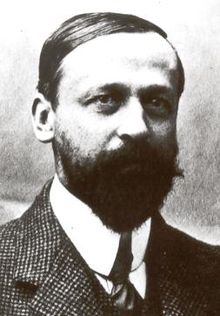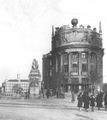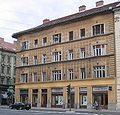- Max Fabiani
-
Max Fabiani, (29 April 1865 – 18 August 1962) was a Slovene-Italian architect from the Gorizia region. Together with Ciril Metod Koch, he introduced the Vienna Secession style of architecture (a type of Art Nouveau) in the Slovene Lands.
Contents
Life
He was born as Maximilian Fabiani in a family of Furlan origin[1] in the village of Kobdilj near Štanjel on the Kras plateau, in what was then the Austro-Hungarian province of Gorizia and Gradisca (now in Slovenia). His father was a farmer and his mother was of an aristocratic family of Tyrolean origin from Trieste. His was a wealthy family which could afford to provide a good education for the children. He grew up in a cosmopolitan trilingual environment: besides Italian, the language of his family, and Slovene,[1] the language of his social environment, he learned German at a very young age.[2]
He attended elementary school in Kobdilj in his father's house, and the German language Realschule in Ljubljana, then moved to Vienna, where he attended architecture courses at the Vienna University of Technology. After earning his diploma in 1889, a scholarship enabled him to travel for three years (1892–1894) to Asia Minor and through most of Europe. When he returned to Vienna, he joined the studio of the architect Otto Wagner on Wagner's personal invitation, and stayed there until the end of the century. During this period he did not only concentrate his interests on design, but also cultivated his vocation as town planner and passionately devoted himself to teaching.
Fabiani's first large-scale architectural project was the urban plan for the Carniolan capital Ljubljana, which was badly damaged by an earthquake in 1895. Fabiani won a competition against the historicist architect Camillo Sitte, and was chosen by the Ljubljana Town Council as the main urban planner. One of the reasons for this choice was Fabiani was considered by the Slovene Liberal Nationalists as a Slovene.[3] With the personal sponsorship of the Liberal nationalist mayor of Laibach Ivan Hribar, Fabiani designed several important buildings in the Carniolan capital, including the Mladika palace, which is now the seat of the Slovenian Foreign Ministry. His work in Ljubljana helped him to become well-known in the Slovene Lands, convincing Slovene nationalists in the Austrian Littoral to entrust him with the design for the National Halls in Gorizia (1903) and in Trieste (1904).[4]
In 1917, he was named professor at the University of Vienna,[5] and in 1919 one of his pupils, Ivan Vurnik, offered him a teaching position at the newly established University of Ljubljana,[6] Fabiani however refused the offer, quit the teaching position in Vienna, and decided to settle in Gorizia, which had been annexed to the Kingdom of Italy, thus becoming an Italian citizen. During the 1920s, he coordinated a large scale reconstruction of historical monuments in the areas in the Julian March that had been devastated by the Battles of the Isonzo during World War I.
In late 1935, he accepted the nomination for mayor (podestà) of his native Štanjel by the Fascist regime, for the National Fascist Party.[2] He remained mayor during World War II, using his knowledge of German language and his cultural acquaintances to convince the German troops to spare the village from destruction.[7][8] He also maintained communication with local Yugoslav partisans. Nevertheless, the monumental fortifications part of the village, which he himself had renovated during the 1930s, were eventually destroyed in the fight between the Wehrmacht and the Slovene partisans.[9]
In 1944, Fabiani relocated back to Gorizia where he lived until his death.
Work
His most important works include: Mladika Palace (Ljubljana, 1896), Palace Portois & Fix (Vienna, 1898), Palace Artaria (Vienna, 1900), Palace Urania (Vienna), the Revenue Office building (Gorizia, 1903), the Narodni dom in Trieste (1904), the urban development plan for Ljubljana (1895), the plan for the reconstruction of Gorizia (1921) and the general urban development plan for Venice (1952).
-
Urania palace in Vienna, built according to Fabiani's plans
-
Hribar's house in Ljubljana
-
Mladika building (now the Foreign Ministry Palace) in Ljubljana
-
Ferrari garden in Štanjel
Awards and honors
Italian Order of Merit for Culture and Art - Roma September 10, 1951.
External links
Notes
- ^ a b Andrej Hrausky and Janez Koželj, Maks Fabiani : Dunaj, Ljubljana, Trst (Ljubljana: Cankarjeva založba, 2010)
- ^ a b Marco Pozzetto, Max Fabiani, MGS PRESS S.a.s., Trieste (1998) p. 15.
- ^ Breda Mihelič, Urbanistični razvoj Ljubljane (Ljubljana: Partizanska knjiga, 1983), 10.
- ^ Marko Kravos et al., Narodni dom v Trstu, 1904-1920 (Trieste-Duino, 1995).
- ^ http://www.rtvslo.si/kultura/razstave/fabiani-kot-mislec-in-clovek/140983
- ^ Janez Koželj et al., Ivan Vurnik, slovenski arhitekt - Slovenian Architect (Ljubljana: Organizacijski odbor projekta Vurnik, 1994).
- ^ Marco Pozzetto, Max Fabiani, MGS PRESS S.a.s., Trieste (1998) p. 72.
- ^ Neera Gatti, Lettere ad un amica, Ergon S.r.l, Gorizia (1951) p. 26,27.
- ^ http://www.slosi.info/01gradovi/02podrobnejse/primorska/ss-7/stanjel3.php
Categories:- 1865 births
- 1962 deaths
- People from Komen
- People from Gorizia
- Italian architects
- Slovenian architects
- Italian people of Austrian descent
- Slovenian people of Friulian descent
- Historicist architects
-
Wikimedia Foundation. 2010.








